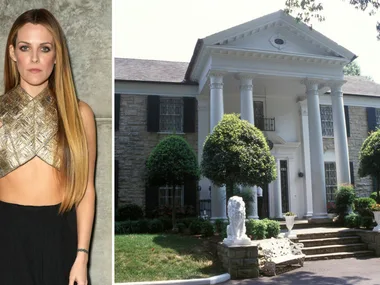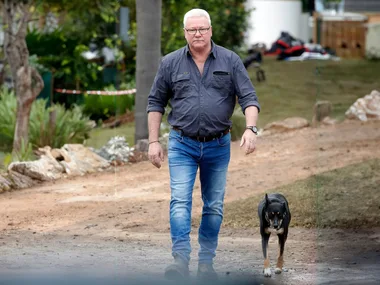Today, Pixie Skase lives in a modest two-bedroom flat in Melbourne. It’s a far cry from the lavish lifestyle she enjoyed with late husband Christopher. Pixie opens her heart to Sue Smethurst, in her first major interview in almost 10 years
Even during the excesses of the 1980s, the extravagance of Christopher and Pixie Skase was legendary. For the opening of their Mirage resort, which lasted five days and cost more than $1 million, chartered jets flew glitterati in from around the world, Krug champagne flowed freely and John Farnham sang for an A-list gathering of high-rollers, politicians and Hollywood celebrities. Their grand mansion on the Brisbane River was the most expensive in Queensland and when the couple commissioned a $6 million yacht to entertain clients, Pixie’s finishing touches were Hermès ashtrays and Christofle silverware.
In pictures: Stars who lost it all
Everyone wanted a piece of their glittering lifestyle – but that was then.
In her first interview since the death of Christopher in 2001, the widow of Australia’s most famous fugitive tells The Weekly about her new, reclusive life and the peace it has brought her. Since she returned to Australia 18 months ago, Pixie has lived in a rented, two-bedroom flat in her old stomping ground of Toorak, with her husky, Nievis.
“I don’t dwell on the past,” she says. “I’ve made a new life and I don’t look back. So many people have said to me, ‘Oh, Pixie, you must miss that lifestyle’, but I don’t. It was another time in my life, another era.”
Being home, she says, is bliss. “I dearly love being here and I am so grateful I’ve been given the opportunity to come home. It is just wonderful to be able to walk around familiar streets of Melbourne and enjoy the autumn leaves falling around the Botanic Gardens, things that I missed so much when we were in Spain.”
Pixie gave her last major interview in 2001, at her Majorcan home, in the days after her husband’s death from stomach cancer. She was grief-stricken, terrified of confronting life on her own and fiercely unapologetic about the 10-year battle they waged against his extradition for charges relating to the $1.5 billion collapse of the Qintex empire. Yet time heals and the grandmother of seven looks remarkably at ease, like the weight of the world has been lifted off her shoulders.
She says she does not miss Christopher. “My life has moved on from my time with him,” she says. “We had a wonderful, passionate relationship and our marriage was exhilarating. The sorrow and grief I felt after his death was all-consuming. I felt totally lost; it was like my whole heart had been wrenched out and I didn’t think I could live without him.
“That grief sat on my shoulders like a block of cement and I had to let it go. I had to accept that he was gone and I had to accept all of the things that happened in our life couldn’t be changed.”
At its height, the Qintex leisure empire was estimated to be worth $2.2 billion, with assets including the Seven Network, Hollywood’s MGM Studios, the then Brisbane Bears AFL club and, the jewel in the crown, the lavish Mirage resort at Port Douglas.
As Australia went into recession in 1989, Qintex collapsed with corporate debts of $1.5 billion and personal debts to the Skases of $172 million. It was a spectacular fall from grace and the couple fled Australia, seeking refuge from creditors on the idyllic Spanish island of Majorca. Christopher faced 32 Australian Securities and Investments Commission charges relating to fraud, but avoided extradition on the grounds he was too sick to travel.
He was labelled a crook, a corporate cowboy and a thief, yet Christopher maintained he’d done nothing wrong, arguing that the collapse of his empire was due to successive governments and the banks. His wife was his most loyal ally.
Pixie has previously remained tight-lipped about the collapse of Qintex, but has broken her silence to The Weekly, saying it’s time to speak out because “when untruths get repeatedly told they become fact”.
The day the business collapsed, she says, was “a whirlwind, just petrifying. It went down like a pack of cards and it was so out of left field. Christopher came home and locked himself in the library. He was very rattled and I knew something was wrong. He had finance people and bank people all around him – it was frenzied. He shielded me from a lot of it, but it was like being in freefall.
“I recall him saying, ‘I feel like I am falling down a glass tube with everyone on the outside and I can’t hear them or touch them.’ It was the most ghastly time and I remember just feeling constantly sick.”
In the early days, Qintex was a family-run operation that began in the living room of their Melbourne home. Pixie worked as Christopher’s secretary and was both a confidante and sounding board. She attended the company’s annual general meetings and says she and Christopher knew many of the shareholders personally, often having tea or coffee with them after the meetings. As the company and their wealth expanded, they moved the operation to Brisbane and, she admits, Christopher made crucial mistakes.
“We lost a lot of that personal contact, which was a great shame,” she says. “The gel that held Qintex together began to disperse and I don’t think Christopher realised quickly enough.”
Christopher could be a poor judge of character, Pixie says. “He trusted too many people and gave too many people the benefit of the doubt. When issues arose, he allowed things to fester, where he should have fixed them. I feel desperately sorry for the shareholders, as did Christopher.
“The only time I have ever seen him cry was when he was discussing the impact of the collapse on the shareholders with Robert Holmes à Court, who was a dear friend.”
Related videoEditor-in-Chief Helen McCabe discusses what’s making news today.
Your say: What do you think of Pixie Skase? Share with us below.
Read more of this article in the July issue of The Australian Women’s Weekly.
Newsletter conversion description. Get the latest in your inbox.































